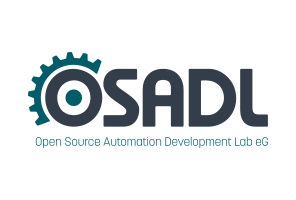Dates and Events:
|
OSADL Articles:
2023-11-12 12:00
Open Source License Obligations Checklists even better nowImport the checklists to other tools, create context diffs and merged lists
2022-07-11 12:00
Call for participation in phase #4 of Open Source OPC UA open62541 support projectLetter of Intent fulfills wish list from recent survey
2022-01-13 12:00
Phase #3 of OSADL project on OPC UA PubSub over TSN successfully completedAnother important milestone on the way to interoperable Open Source real-time Ethernet has been reached
2021-02-09 12:00
Open Source OPC UA PubSub over TSN project phase #3 launchedLetter of Intent with call for participation is now available |
Real Time Linux Workshops
1999 - 2000 - 2001 - 2002 - 2003 - 2004 - 2005 - 2006 - 2007 - 2008 - 2009 - 2010 - 2011 - 2012 - 2013 - 2014 - 2015
13th Real-Time Linux Workshop from October 20 to 22 at the Faculty of Electrical Engineering, Czech Technical University in Prague
Announcement - Hotels - Directions - Agenda - Paper Abstracts - Presentations - Registration - Abstract Submission - Sponsoring - Gallery
Safety logic on top of complex hardware software systems utilizing dynamic data types
Nicholas Mc Guire, Distributed and Embedded Systems Lab, SISE, Lanzhou University
Utilizing computers for safety critical systems, notably contemporary super scalar multi-cores, let alone NUMA systems running general purpose operating systems like GNU/Linux, is quite contended in the safety community - their hopes still rest on determinism and KISS. While keeping things simple in the safety related components is undoubtedly preferred, it is questionable if keeping the hardware model simple is realistic - notable with the divergence of reality from model with respect to determinism already being dramatic for widely used general-purpose single-core CPUs. Further actually deterministically covering the impact of all complex software components is not doable with an economically tolerable effort (if it is technically doable is a different issue).
The consequence of this belief in determinism, is an, in our opinion useless, fight against complexity and non-determinism - two inherent properties of modern hardware/software systems. Quite to the contrary, we propose to utilize the properties of complex systems to enhance safety related systems. This seemingly paradox approach can be seen as an attempt to take the bull by the horns as it seems inevitable that the time of simple CPUs and black-box proprietary operating systems, that continue to entertain the illusion of determinism, is coming to and end.
Safety mechanisms, drawing enhancements from underlying complexity, we see as potentially suitable for building safety related systems are:
- computation: Inherent diversity
- data: mapping value domain to complex data representations
- time: loos coupling: inherent randomness
and we are quite sure that this little list is incomplete at this point.
In this article we will describe an attempt at the second category called dynamic data types, which essentially combine the value domain with the temporal properties of data to map data to a value in the frequency domain rather than to a value in the time-domain. We outline the concept of dynamic data types and a rational for why it seems a promising approach for covering of particular fault classes. Finally we describe how building simple logic utilizing dynamic data types on complex systems can yield a safe system never the less and thus allow to co-locate safety related logic with non-safety related general purpose applications and services on a single contemporary system.




